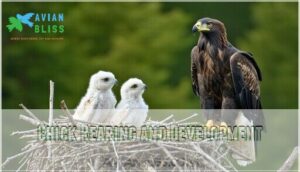This site is supported by our readers. We may earn a commission, at no cost to you, if you purchase through links.
 Golden eagle breeding unfolds as nature’s supreme power play, where these dominant predators transform into devoted parents during their March-August breeding season. You’ll witness a four-month commitment from egg-laying to fledging, with migratory populations compressing this cycle into tight windows of favorable weather.
Golden eagle breeding unfolds as nature’s supreme power play, where these dominant predators transform into devoted parents during their March-August breeding season. You’ll witness a four-month commitment from egg-laying to fledging, with migratory populations compressing this cycle into tight windows of favorable weather.
These impressive raptors construct massive platform nests up to six feet across, collaborating as partners to build structures that can endure decades. The female incubates eggs for 42 days while her mate provides constant provisions, then both parents work tirelessly feeding and protecting their rapidly developing chicks.
However, modern threats from habitat fragmentation and human interference are reshaping these ancient breeding patterns in ways that reveal surprising adaptations.
Table Of Contents
- Key Takeaways
- Golden Eagle Breeding Season and Timing
- Courtship, Pair Formation, and Mating
- Nest Building and Site Selection
- Egg Laying and Incubation
- Chick Rearing and Development
- Breeding Habitat, Conservation, and Threats
- Frequently Asked Questions (FAQs)
- What is the mating ritual of the golden eagle?
- What is the nesting behavior of the golden eagle?
- How many babies can a golden eagle have?
- How long does it take for a golden eagle to fledge?
- How do golden eagles choose their mates?
- Can golden eagles breed with other eagle species?
- What age do golden eagles start breeding?
- How often do golden eagles produce successful broods?
- Do golden eagles reuse nests from previous years?
- How many years do golden eagles mate for life?
- Conclusion
Key Takeaways
- You’ll witness a remarkable four-month commitment from March to August as golden eagles complete their entire breeding cycle, with migratory populations compressing this timeline into tight seasonal windows while residents enjoy extended courtship periods.
- These raptors construct massive platform nests up to six feet across that can last for decades, with both partners collaborating on building and annual maintenance to create structures weighing thousands of pounds on cliff faces and tall trees.
- You’ll observe distinct parental roles during the 42-day incubation period, where females handle most egg duties while males provide constant food provisioning, followed by an intensive 11-12 weeks of chick rearing until fledging.
- Modern conservation challenges from habitat fragmentation and human interference are forcing these ancient breeding patterns to adapt, with wind turbine strikes, development pressure, and climate change reducing breeding success rates by up to 25% in some regions.
Golden Eagle Breeding Season and Timing
Golden eagles time their breeding season between March and August in North America, with the entire process lasting approximately four months from egg-laying to fledging. Migratory populations must compress their breeding activities into a tighter five-month window of favorable weather, while resident eagles can begin courtship and nest preparation months earlier.
Breeding Period and Seasonal Occurrence
You’ll find golden eagles breaking free from winter’s grip to embrace their breeding cycles during distinct seasonal patterns. Their breeding period usually spans February through July, with timing varying by latitude and elevation.
Winter’s grip loosens as golden eagles begin their breathtaking courtship displays across rugged territories
Key seasonal occurrence factors include:
- Northern populations – Begin mating rituals in March-April when prey abundance peaks
- Southern regions – Start breeding as early as December due to milder conditions
- High elevations – Delay nesting schedules 1-2 months compared to lowland sites
Weather events can shift these fledging rates substantially, with late snowstorms postponing activities for weeks. This natural flexibility guarantees successful reproduction across diverse habitats.
Egg-laying Months and Climate Influences
You’ll witness nature’s perfectly timed choreography when golden eagles synchronize egg laying with favorable weather patterns. Climate effects dictate breeding success—harsh winters delay reproduction, while mild springs accelerate cycles. Temperature influence determines egg dates, with females postponing laying during unfavorable conditions to boost chick survival rates.
| Month | Climate Factor | Egg-laying Response |
|---|---|---|
| March | Early spring warmth | Accelerated laying begins |
| April-May | Ideal temperatures | Peak breeding activity |
| June | Late cold snaps | Delayed or suppressed laying |
Weather patterns control the entire breeding timeline. Eagles won’t risk their precious clutches during temperature extremes or storms. This egg delay strategy guarantees incubation period success when conditions stabilize, demonstrating exceptional adaptive intelligence in breeding season timing.
Differences Between Migratory and Resident Populations
Exploring different migration patterns reveals fascinating breeding strategies between resident and migratory golden eagle populations. Resident eagles enjoy extended courtship periods, building stronger pair bonds months before egg-laying begins.
Meanwhile, migratory populations must compress their entire breeding cycle into a tight five-month window, creating intense pressure to succeed quickly in establishing breeding territories.
Courtship, Pair Formation, and Mating
Golden eagles engage in breathtaking aerial courtship displays that strengthen pair bonds before breeding season begins. You’ll observe these monogamous raptors performing synchronized dives, talon-grappling, and soaring dances that can last for hours as they establish territories and prepare for nesting.
Courtship Displays and Bonding Rituals
Golden eagles perform breathtaking courtship displays that cement lifelong bonds. You’ll observe males executing dramatic skydancing maneuvers, diving at speeds exceeding 150 mph before pulling up sharply. These aerial acrobatics demonstrate fitness during pair formation.
Courtship rituals include synchronized flights, talon-grappling, and food transfers. Display behaviors intensify near potential nest sites, with both partners participating in elaborate flight patterns that establish monogamous relationships through powerful bonding mechanisms.
Monogamous Partnerships and Territory Defense
Once you understand courtship displays, pair bonding becomes the foundation of golden eagle relationships. These impressive raptors form monogamous relationships that usually last for life, with mate fidelity rates exceeding 90%.
Established pairs defend massive breeding territories ranging from 35 to 155 square kilometers, using coordinated patrols and territorial boundaries to secure essential resources for successful reproduction. The defense of their territory involves complex strategies related to territorial behavior.
Pair Behavior in Migratory Vs. Non-migratory Eagles
Migration Patterns fundamentally reshape how golden eagles approach Pair Bonding and breeding behavior. Nonmigratory eagles enjoy extended courtship periods, building relationships over months before egg-laying begins. These resident pairs can afford leisurely mate selection and territory establishment.
In contrast, migratory eagles face compressed timelines, arriving at breeding grounds with urgent mating strategies. They must quickly form pair bonds and secure territories within narrow seasonal windows, making their Social Interactions more intense and focused than their sedentary counterparts.
Nest Building and Site Selection
Once you understand golden eagle nest construction, you’ll appreciate the outstanding engineering that goes into creating these massive structures. Golden eagles build platform nests using coarse branches and fine materials, choosing cliff faces, tall trees, or raised structures that provide both protection and commanding views of their hunting territory.
Platform Nest Construction and Materials
After bonding pairs secure their territory, they’ll construct massive platform nests that showcase impressive building techniques. These architectural marvels demonstrate complex material selection and nest construction methods:
- Coarse branches form the sturdy foundation, with eagles selecting weathered wood that resists cliff erosion
- Fine grasses and moss create comfortable interior lining for nest camouflage
- Fresh greenery gets added seasonally to maintain nest architecture
- Accumulated debris increases nest size over decades of continuous use
The platform nest construction requires both partners working together, building structures that can span six feet across. This collaborative effort involves detailed nest building facts that guarantee the nest’s stability and protection.
Preferred Nest Locations—cliffs, Trees, Structures
You’ll find golden eagles strategically selecting nest sites across diverse landscapes. Towering cliffs provide supreme security from predators, with nesting elevations reaching 10,000 feet. These raptors favor cliff faces with adequate ledges while considering cliff erosion patterns for long-term stability.
Tree species like pines and cottonwoods offer alternative nest placement when cliffs aren’t available. Structure height becomes critical—whether natural formations or human-made towers, eagles demand commanding views of their hunting territories for ideal nest site selection.
Shared Nest Building Roles and Annual Maintenance
Both partners share nest-building duties, with the female usually taking the lead in material selection. You’ll find them working together throughout the breeding season to maintain their aerial fortress.
Key nest building and maintenance activities:
- Nest repair – Patching winter damage with fresh branches
- Cooperative building – Both eagles transport materials to the site
- Material selection – Choosing sturdy branches, softer lining materials
- Nest renovation – Adding new layers annually for structural integrity
These maintenance strategies guarantee the nest remains viable for decades. The shared workload strengthens pair bonds while creating a fortress that can withstand harsh weather and accommodate growing chicks.
Nest Size, Depth, and Longevity
Golden eagle nest architecture showcases impressive dimensions. You’ll find typical nest diameter ranging from 5 to 8.5 feet, with platform depth averaging 2 to 3 feet initially but reaching remarkable depths up to 23 feet through decades of nest reuse. This nest longevity creates monumental structures weighing thousands of pounds, defying cliff erosion and weather challenges for generations.
The construction of these nests is influenced by the eagles’ habitat conservation efforts, which play a vital role in their survival.
Egg Laying and Incubation
Once you’ve completed nest preparation, your eagles will proceed to the critical egg-laying phase, usually producing 1-3 eggs per clutch with an incubation period of 42 days.
You’ll observe distinct parental roles during this stage, as females handle most incubation duties while males provide food and occasional relief coverage.
Clutch Size and Egg Characteristics
You’ll usually find two eggs nestled in each Golden Eagle clutch, though clutch size varies from one to three eggs depending on prey abundance and female condition. These pale, brown-speckled treasures measure approximately three inches in egg length, with egg width proportionally sturdy. The egg description reveals distinctive egg coloration featuring scattered brown blotches across cream backgrounds.
Yolk formation facilitates critical embryo development phases, while average egg size remains consistent across populations, establishing favorable conditions for successful hatching. Understanding egg incubation techniques is essential for the survival of these eggs.
Incubation Period and Parental Roles
Dedication defines the 42-day incubation period for golden eagles. You’ll observe the female handling most incubation duties while males provide food and brief relief. Both parents master egg turning and temperature regulation through refined brooding techniques.
- The female’s unwavering commitment: She rarely leaves the nest, maintaining constant vigilance over precious eggs.
- Synchronized teamwork: Partners coordinate flawlessly, ensuring eggs never face abandonment during critical development.
- Temperature mastery: Parents adjust their bodies like living thermostats, creating perfect conditions for growing nestlings.
Factors Affecting Egg-laying and Delays
Environmental pressures dramatically influence when you’ll observe golden eagles beginning their egg-laying period. Weather conditions, particularly late snow and harsh storms, can delay clutch initiation by weeks. Food availability proves critical—abundant prey cycles trigger earlier breeding, while scarcity forces postponement or complete breeding suspension. Human disturbances and habitat degradation create additional breeding stress, often resulting in delayed or suppressed egg-laying attempts across territories.
The golden eagle’s reproductive success is heavily dependent on prey abundance factors that affect their breeding habits.
Nest Predators and Egg Survival
Predators pose significant threats during the vulnerable egg incubation period. Ravens, crows, and other corvids frequently raid unguarded nests, while mammals like foxes and martens climb cliff faces to reach nest sites.
Nest security depends heavily on strategic site selection and constant parental vigilance. Egg camouflage provides minimal protection, making brood protection through territorial defense essential for nesting success.
Chick Rearing and Development
Once your eaglets hatch after 42 days of incubation, you’ll witness an intensive period of parental care that lasts approximately 11-12 weeks until fledging. During this critical development phase, both parents work tirelessly to provide food, protection, and thermoregulation for their vulnerable chicks as they transform from helpless hatchlings into powerful aerial predators capable of independent survival.
Nestling Care and Feeding Strategies
Once eaglets hatch, you’ll witness notable feeding behaviors as parents launch into high-gear foraging tactics. The male usually hunts while the female stays close, tearing prey into bite-sized pieces for developing chicks. Parental care intensifies during this critical nestling period as eaglets demand constant nutrition for rapid chick growth.
- Feeding frequency: Parents deliver food 3-6 times daily during peak nestling period
- Prey selection: Adults target smaller, easier-to-process mammals and birds for young eaglets
- Food processing: Female tears large prey into manageable portions using powerful talons and beak
Brooding, Thermoregulation, and Protection
Following your clutch through the critical incubation period, you’ll watch parent eagles demonstrate exceptional brooding behavior as they shield vulnerable nestlings from temperature extremes. The nest microclimate becomes their sanctuary, where parental care includes constant shelter and protection.
Both adults regulate chick temperature through precise positioning, creating ideal conditions for feather development. This dedicated care of young continues throughout nesting biology phases.
Fledgling Development and Independence
As chicks mature into their Independence Stage, they develop the skills needed to break free from parental dependency. Fledgling Growth accelerates rapidly as eaglets prepare to fledge, usually around 65-75 days after hatching. Wing Training becomes intense during this period.
- Feather Development: Flight feathers reach full length, providing lift capacity
- Wing exercises: Eaglets practice flapping and short hops within the nest
- Hunting Skills: Parents demonstrate prey capture techniques nearby
- Food begging: Chicks vocalize persistently to maintain parental feeding
- Pre-fledging exploration: Young eagles venture to nest edges and nearby branches
Life Expectancy and Mortality Causes
Wild golden eagles face tough odds in their early years, with over 60% of juveniles not surviving their first year. Life expectancy averages 14-20 years in the wild, though some reach 30+. Leading mortality causes include starvation, predation, disease, and human-related deaths from collisions and poisoning.
Adult plumage development signals maturity around age five, when survival rates improve substantially.
Breeding Habitat, Conservation, and Threats
Golden eagles require vast territories and specific habitat features for successful breeding, making them vulnerable to human development and environmental changes.
Understanding their conservation status helps protect these impressive raptors and their critical breeding grounds across North America.
Breeding Territories and Habitat Preferences
You’ll find golden eagles claiming vast breeding territories that span 20-50 square miles of rugged terrain. These raptors select breeding habitat featuring dramatic landscape features like mountain ridges, canyon walls, and cliff faces at elevations between 1,000-12,000 feet. Territory size varies with prey density and habitat fragmentation.
Prime nesting microhabitats include sheltered ledges on vertical rock faces, providing protection and commanding views of their domain. Understanding the golden eagle’s natural habitat needs is essential for conservation efforts.
Human Impact and Environmental Threats
Human activities devastate golden eagle breeding success through multiple pathways. Habitat Fragmentation from energy development destroys nesting sites, while Wind Turbine Strikes kill up to 75 eagles annually in California alone. Human Disturbance within 400-1,500 meters causes nest abandonment.
Pollution Effects include lead poisoning and rodenticide contamination.
Climate Change alters prey availability and increases weather extremes, reducing breeding success by 25% in some regions.
Protection Laws and Conservation Initiatives
Federal laws protect Golden Eagles through thorough Wildlife Legislation, including the Bald and Golden Eagle Protection Act and Migratory Bird Treaty Act. These Environmental Policies establish strict Species Protection standards, making harassment or killing eagles a federal crime.
Conservation Initiatives focus on three key areas:
- Habitat Preservation programs safeguarding nesting territories
- Wind Turbine Strikes mitigation through strategic turbine placement
- Human Impact reduction via public education campaigns
These Conservation Efforts maintain the species’ protected Conservation Status. Understanding wildlife laws is essential for effective species protection and conservation planning.
Breeding Population Trends and Research Efforts
Current research reveals troubling breeding population trends across golden eagle territories worldwide. North American surveys document roughly 30,000 individuals, while European populations show regional declines since the late 20th century. Modern research methods, including GPS telemetry, nest cameras, and citizen science through Breeding Bird Survey data, augment species monitoring efforts.
Habitat fragmentation from renewable energy expansion poses significant threats to breeding territories, prompting targeted conservation strategies to address population decline and protect critical nesting behavior patterns. Understanding bird conservation threats is essential for developing effective protection plans for these species.
Frequently Asked Questions (FAQs)
What is the mating ritual of the golden eagle?
You’ll observe their breathtaking aerial courtship displays featuring synchronized diving, soaring, and cartwheels. Mated pairs perform these acrobatic flights together, sometimes locking talons and cartwheeeling earthward before separating.
What is the nesting behavior of the golden eagle?
Nests can last decades — you’ll find golden eagles building massive platform structures from coarse branches on cliffs, trees, or raised sites, with females selecting locations while both parents construct their multi-generational homes.
How many babies can a golden eagle have?
Golden eagles usually lay 1-3 eggs per clutch, with 2 being most common. You’ll find these pale, brown-spotted eggs hatch after 42 days of incubation, producing eaglets that depend entirely on their parents.
How long does it take for a golden eagle to fledge?
Time flies when you’re watching eaglets grow! Golden eagle chicks usually fledge (leave the nest) after approximately 66-75 days from hatching, though they’ll remain dependent on their parents for several additional weeks.
How do golden eagles choose their mates?
You’ll witness their aerial courtship displays where pairs perform breathtaking sky dances, diving and soaring together. Established pairs often mate for life, strengthening bonds through shared hunting and nest-building activities each breeding season.
Can golden eagles breed with other eagle species?
Can interspecies eagle breeding actually work? Golden eagles rarely hybridize with other eagle species due to different breeding behaviors, habitats, and genetic compatibility issues, though occasional crosses with other Aquila eagles have been documented.
What age do golden eagles start breeding?
You’ll find that mature golden eagles usually begin breeding around 4-5 years old, though some individuals may start as early as 3 years or delay until age 6-7 depending on territory availability and environmental conditions.
How often do golden eagles produce successful broods?
Breeding birds bring broods to fruition with outstanding consistency. You’ll find golden eagles usually raise one successful brood per year, achieving approximately 70-80% breeding success rates under favorable conditions.
Do golden eagles reuse nests from previous years?
Yes, you’ll usually find golden eagles reusing their sturdy platform nests year after year. These impressive structures can serve the same pair for decades, growing larger with each season’s additions.
How many years do golden eagles mate for life?
Like two souls bound by invisible threads, you’ll find that golden eagles usually mate for life, forming monogamous pair bonds that can last many years, though they may find new partners if one dies.
Conclusion
Understanding golden eagle breeding reveals these majestic raptors’ impressive adaptability across diverse environments. From their elaborate courtship displays to four-month parental commitment, golden eagle breeding demonstrates nature’s intricate balance between survival and reproduction.
You’ve learned how these dominant predators construct enduring platform nests, share incubation duties, and face modern conservation challenges. As habitat pressures intensify, protecting breeding territories becomes essential for maintaining stable populations and preserving this species’ ancient reproductive strategies.
- https://avianreport.com/golden-eagle-breeding/
- https://pubs.usgs.gov/of/2015/1039/pdf/ofr2015-1039.pdf
- https://eplanning.blm.gov/public_projects/2022592/200551215/20116118/251016098/06%20BRTR_App%20E_Golden%20Eagle%20Report.pdf
- https://www.fws.gov/species/golden-eagle-aquila-chrysaetos
- https://bioone.org/journals/journal-of-raptor-research/volume-51/issue-3/JRR-16-46.1/Coming-to-Terms-About-Describing-Golden-Eagle-Reproduction/10.3356/JRR-16-46.1.pdf














